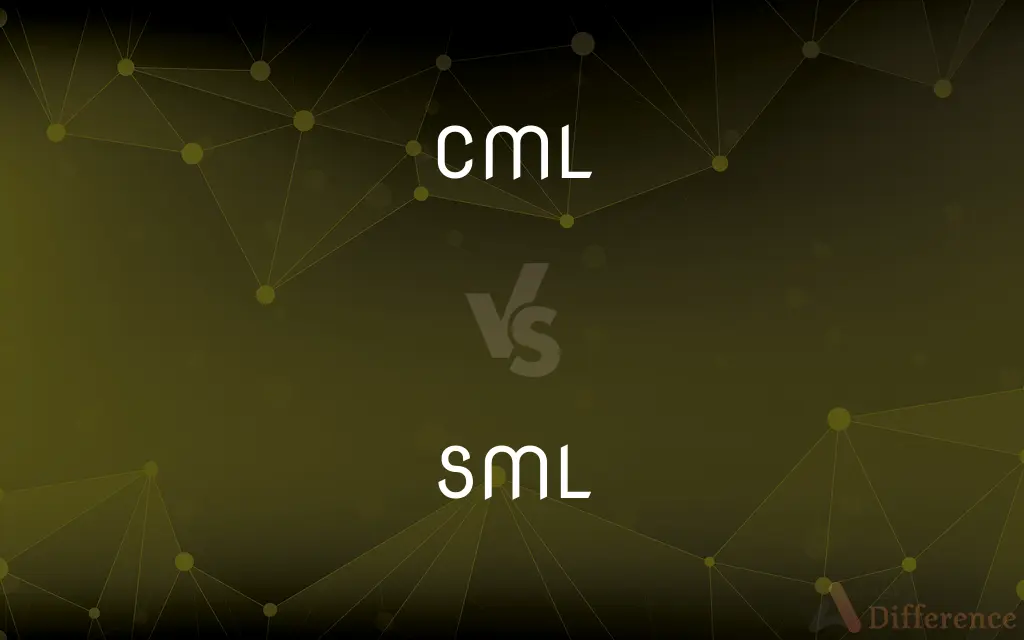CML vs. SML — What's the Difference?
By Tayyaba Rehman — Published on January 22, 2024
CML (Capital Market Line) represents investment portfolios' risk-reward profiles using market portfolio; SML (Security Market Line) shows expected returns of individual assets considering systematic risk.

Difference Between CML and SML
Table of Contents
ADVERTISEMENT
Key Differences
The Capital Market Line (CML) represents portfolios that optimally combine risk and return in the capital market, based on the market portfolio and risk-free rate. The Security Market Line (SML), however, represents the expected return of individual assets or portfolios, considering their systematic risk, also known as beta.
CML is derived from the capital asset pricing model (CAPM) and plots the risk (standard deviation of returns) against expected return, including all types of investment portfolios. SML, a line within the CAPM framework, shows the relationship between beta and expected return for individual securities.
In the CML context, all portfolios on the line offer the highest possible expected return for a given level of risk. SML, conversely, evaluates the performance of individual securities and determines if they are undervalued or overvalued based on their position relative to the SML.
CML uses total risk (standard deviation) to assess portfolios, which is relevant for diversified portfolios, including the market portfolio. SML focuses only on systematic risk (market risk) and disregards unsystematic risk, as it is assumed to be diversified away.
CML is practical for comparing different portfolios against the market portfolio, assisting investors in choosing diversified investments. SML is useful for evaluating the risk-return profile of individual securities, guiding investors in stock-specific decisions.
ADVERTISEMENT
Comparison Chart
Representation
Optimal portfolios combining risk and return
Expected return of individual assets
Based on
Total risk (standard deviation)
Systematic risk (beta)
Use in Investment
Comparing diversified portfolios
Evaluating individual securities
Risk Assessment
Considers total risk
Focuses on market risk
Application
Choosing diversified investments
Stock-specific investment decisions
Compare with Definitions
CML
CML depicts portfolios with the best risk-return combination.
An investor uses the CML to identify optimal investment portfolios.
SML
SML is part of the capital asset pricing model.
An investor used the SML to compare the expected return of different stocks.
CML
CML is a graphical representation in the CAPM framework.
The CML helped in understanding the risk-return profile of the market portfolio.
SML
SML shows expected returns based on systematic risk.
SML indicates if a stock is undervalued based on its beta.
CML
CML measures total risk through standard deviation.
The slope of the CML shows the reward per unit of total risk.
SML
SML focuses on beta, disregarding unsystematic risk.
The SML was instrumental in evaluating the systematic risk of a portfolio.
CML
CML is used for evaluating diversified portfolios.
The CML guides investors in assessing the efficiency of their investment portfolios.
SML
SML represents the market risk-reward relationship.
The slope of the SML measures the market risk premium.
CML
CML intersects the y-axis at the risk-free rate.
The point where CML crosses the y-axis indicates the return of risk-free assets.
SML
SML helps in identifying overvalued or undervalued securities.
A stock above the SML line is considered undervalued.
Common Curiosities
What is the main purpose of the CML?
To show the risk-reward profile of investment portfolios.
Does CML consider total risk or just market risk?
It considers total risk including market risk.
What does CML stand for?
Capital Market Line.
Is the CML practical for individual stocks?
No, it’s more suitable for diversified portfolios.
What does SML stand for?
Security Market Line.
How does the SML help in stock valuation?
By identifying if stocks are undervalued or overvalued.
How is the CML used in investment analysis?
For comparing the efficiency of diversified portfolios.
How are CML and SML different in risk assessment?
CML assesses total risk; SML assesses only systematic risk.
Does SML focus on total risk?
No, it focuses on systematic (market) risk only.
Can SML be used for portfolio analysis?
It's mainly used for individual securities rather than portfolios.
What is systematic risk in the context of SML?
The risk inherent to the entire market or market segment.
What is the key purpose of the SML?
To relate individual asset returns to their systematic risk.
Can the CML and SML intersect?
No, they are based on different risk measurements.
Is the risk-free rate relevant in SML?
Yes, it's where the SML intersects the y-axis.
Are CML and SML tools for everyday investors?
They are more commonly used by financial professionals and analysts.
Share Your Discovery

Previous Comparison
Autoclave Sterilizer vs. Dry Heat Sterilizer
Next Comparison
Register vs. CacheAuthor Spotlight
Written by
Tayyaba RehmanTayyaba Rehman is a distinguished writer, currently serving as a primary contributor to askdifference.com. As a researcher in semantics and etymology, Tayyaba's passion for the complexity of languages and their distinctions has found a perfect home on the platform. Tayyaba delves into the intricacies of language, distinguishing between commonly confused words and phrases, thereby providing clarity for readers worldwide.
















































